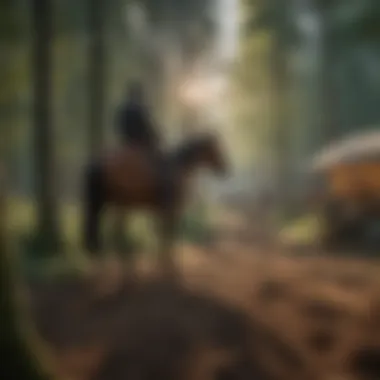Exploring Equestrian Sites and Their Cultural Significance


Intro
In an increasingly urbanized world, the significance of equestrian sites is often overshadowed by other landscapes and recreational areas. These sites, however, carry a deep historical legacy and cultural importance that extends beyond mere leisure activities. They serve as loci for community engagement, education, and the preservation of equestrian traditions that have spanned generations.
This article ventures into the multifaceted realm of equestrian sites. It scrutinizes their historical context, various applications in contemporary culture, and the evolution of the facilities that support both competitive and recreational horseback riding. We will also consider the integration of advanced technology in horse management and how equestrian sports are contributing to environmental awareness.
Understanding these sites is crucial not only for horse lovers but also for anyone interested in history, culture, and community resilience. Through a deeper examination of notable equestrian facilities and practices, we will uncover their unique characteristics and the benefits they offer to individuals and communities alike.
Prologue to Equestrian Sites
Equestrian sites carry a richness that extends beyond their immediate purpose. They are cultural hubs that embody a blend of history, tradition, and community. Understanding equestrian sites is essential as they play a vital role in modern society. Their significance lies in their ability to foster connection among people, convey related traditions, and promote educational opportunities. An exploration of equestrian sites reveals not just their recreational possibilities but also the power they hold in shaping societal values.
Definition of Equestrian Sites
Equestrian sites refer to any locations where activities related to horse riding, training, care, and competition take place. This includes riding schools, equestrian centers, and horse racing tracks. Essentially, these sites serve as places for learning, leisure, and performance. They offer facilities where enthusiasts can engage in various equestrian activities, from riding lessons for beginners to competitive events for seasoned riders. Thus, understanding what equestrian sites are allows us to appreciate their expansive role within both local and global contexts.
Historical Overview
The historical roots of equestrian sites are deep and varied. The bond between humans and horses dates back thousands of years. Initially, horses were domesticated for transportation and agriculture, leading to the establishment of structured facilities where horses could be trained and cared for. Over centuries, the development of equestrian culture began, leading to the creation of spaces dedicated specifically for riding and competitions.
During the Middle Ages in Europe, mounted knights and their horses were central figures in warfare and nobility. This period also saw the emergence of dedicated riding schools, which began formalizing the art of equitation. By the 19th century, equestrianism further evolved into a celebrated sport, with the establishment of numerous race tracks and competitive venues. The continued evolution of riding disciplines, from classical dressage to modern show jumping, highlights the ongoing significance of equestrian sites.
Understanding this historical context enriches our perspective of equestrian sites today. They are not just venues for entertainment but also custodians of a rich heritage that links past practices with contemporary culture. This narrative lays the groundwork for the subsequent exploration of the various types of equestrian facilities and their roles in society.
Types of Equestrian Facilities
Understanding the different types of equestrian facilities is valuable. These sites serve multiple purposes and play crucial roles in the equestrian landscape. They offer not just a space for riding, but also foster community, tradition, and sport. As we delve into each type, we will uncover their significance and contributions to equestrian culture.
Riding Schools
Riding schools are foundational in the equestrian community. They cater to a wide range of skills, from beginners to advanced riders. The main aim of these institutions is to provide quality instruction in horsemanship. The instructors often focus not only on riding skills but also on the care and management of horses. This comprehensive approach promotes responsible ownership among new riders.
Riding schools often offer a variety of programs. Some focus on specific disciplines such as dressage, jumping, or eventing. Others provide general riding courses that encompass a mix of styles. Many have horses available for students who may not own one, allowing wider accessibility. The social interaction among learners and trainers fosters a sense of community. This aspect can be particularly beneficial for youth, helping to teach teamwork, discipline, and empathy.
It is important to note the role of riding schools in maintaining equestrian traditions. They often host events, competitions, and exhibitions that highlight local equestrian culture.
Equestrian Centers
Equestrian centers generally encompass larger facilities that offer diverse services. Unlike riding schools, these centers may include stabling, training, and competition arenas. They cater to both recreational riders and professional athletes. Many centers provide comprehensive care for horses, which is crucial for health and performance.
These centers often serve as community hubs, hosting events that draw participants and spectators. They may organize clinics, workshops, and horse shows that are open to the public. The educational component is vital, promoting knowledge about proper care and advanced riding techniques. Moreover, centers that engage with the local community can stimulate economic activity through tourism and participation.
In recent years, many equestrian centers have started to focus on sustainable practices. This impacts not just the equestrian community but also promotes environmental awareness.
Horse Racing Tracks
Horse racing tracks represent a distinct segment within the equestrian facilities landscape. These venues are dedicated to the sport of horse racing and are often associated with a long-standing tradition. Racing events attract large crowds, providing entertainment and a sense of community engagement.
Beyond entertainment, horse racing tracks play a significant economic role in their regions. They can generate substantial revenue through betting, tourism, and related businesses. Additionally, these tracks often support horse breeding and training, creating a robust industry surrounding the sport.
Racing tracks also contribute to the cultural narrative of a region. They can be pivotal in promoting equestrian excitement and heritage, with nostalgic connections to societal practices. However, this must be balanced with ethical considerations in horse care and welfare.
"Horse racing tracks are not only about competition but also about community, heritage, and economic impact."
Understanding these facilities helps to appreciate the wider context of equestrianism, revealing its layers of significance in society. Each type of facility brings its unique strengths, contributing to a dynamic equestrian culture.
Cultural Significance of Equestrian Sites
Equestrian sites play a key role in culture, symbolizing human connection with horses. These places are more than just venues for sports or recreation; they are centers where traditions thrive and communities gather. Understanding their cultural significance offers insight into both historical and contemporary societal values surrounding horses.
Equestrian Traditions and Heritage


Equestrian traditions encompass a diverse range of practices and beliefs. From ancient civilizations to modern societies, horses have served both practical and symbolic roles. In many cultures, horses are not only transportation but also a status symbol. Equestrian events, such as rodeos or dressage, invite participants and spectators to appreciate this bond. Heritage is preserved in stories, arts, and crafts related to horses. Traditional horsemanship techniques passed down through generations serve as a living testament to cultural identity.
Historically, equestrian activities were essential for survival. In places like Mongolia, nomadic tribes have used horses for hunting and migration. Today, cultural practices such as the Spanish Riding School showcase classical dressage rooted in military training. Such sites are crucial in safeguarding these traditions against the test of modernization.
Role in Community Development
Equestrian sites can influence community dynamics significantly. They provide space for social gathering, education, and economic activities. Communities hosting these sites often see increased tourism and local business growth. Riding schools and equestrian centers organize events that foster community spirit, bringing together individuals from varied backgrounds, creating networks of support and collaboration.
Furthermore, equestrian programs often focus on youth and education. They offer learning opportunities that teach responsibility and empathy through horse care. Programs targeted at underprivileged youth can have profound impacts, providing mentorship and engagement that may otherwise be lacking.
In summary, the cultural significance of equestrian sites spans rich traditions and community development. Their roles not only enhance cultural heritage but also contribute to building cohesive communities. Understanding this significance is essential for appreciating the legacy and future of these invaluable spaces.
Equestrian Sports and Their Influence
Equestrian sports serve as a vital aspect of the broader tapestry of equestrian culture. They encapsulate the synergy between humans and horses while showcasing the rich traditions as well as the competitive spirit deeply rooted in many societies. Engaging in these sports involves various disciplines, each offering unique benefits and challenges. This section highlights the core elements that define equestrian sports and their far-reaching impacts on communities and the economy.
Overview of Popular Equestrian Sports
Within the realm of equestrian sports, several disciplines stand out in popularity, including dressage, show jumping, and eventing. Each sport has its own set of skills and training requirements, appealing to diverse participants.
- Dressage: Often regarded as the most artistic of equestrian sports, it emphasizes the harmony between horse and rider. Competitors demonstrate a series of predetermined movements known as "tests" in arenas, showcasing precision and training.
- Show Jumping: This sport tests both speed and agility as horse and rider navigate a course of jumps. It is a thrilling spectacle, drawing large audiences and fostering a competitive atmosphere.
- Eventing: A triathlon of sorts for equestrian athletes, eventing combines dressage, cross-country, and show jumping. This discipline demands resilience and versatility from horse and rider, making it a true test of partnership.
These sports not only promote an appreciation of equestrian talent but also encourage community involvement through competitions and events, drawing spectators and participants alike.
Economic Impacts of Equestrian Events
Equestrian events significantly contribute to local and regional economies. They create jobs, stimulate tourism, and foster community pride. The economic impacts can be summarized as follows:
- Tourism Boost: Major equestrian events bring in spectators from various regions, resulting in increased hotel bookings, restaurant patronage, and retail sales. This influx positively influences local businesses and improves the area’s economic health.
- Job Creation: Organizing these events often requires a large workforce. This includes roles in event management, hospitality, as well as horse care. Many equestrian centers and venues employ local residents, supporting their livelihoods.
- Sponsorship and Investment: High-profile equestrian competitions attract sponsorships from businesses seeking visibility. This financial backing is crucial for the sustainability of these events and helps promote equestrian sports further.
Equestrian sports showcase the importance of horse-related activities not just for the enthusiasts but also for broader societal benefits. As communities rally around their equestrian traditions, they not only preserve cultural heritage but also create economic opportunities.
"Equestrian sports are not merely competitions; they are cultural expressions that unite communities and drive economic vitality."
In sum, the influence of equestrian sports extends far beyond individual enjoyment and performance. They enrich cultural landscapes while fostering economic growth.
Conservation and Sustainability in Equestrian Activities
Conservation and sustainability are crucial in the context of equestrian activities. As engagement with horses and equestrian culture increases, so does the responsibility for the environmental impacts these activities generate. Unlike some other leisure activities, equestrianism has unique challenges related to land use, resource management, and animal welfare.
Failing to address these issues can lead to detrimental effects on natural habitats, water quality, and even the health of the horses involved. Sustainable practices within equestrian activities promote harmony between the enjoyment of riding and the preservation of ecological systems. They ensure that future generations can also appreciate the benefits that these activities provide.
Important considerations include soil management to prevent erosion, effective waste disposal methods, and the use of native plants in landscaping at equestrian facilities. By integrating sustainability into everyday functions, equestrian sites can become models of environmental stewardship.
Best Practices in Sustainable Riding
Sustainable riding practices are essential for reducing the negative impacts on the environment from equestrian activities. Here are some best practices:
- Horse Nutrition: Use locally sourced feeds that reduce the carbon footprint associated with long-distance transportation.
- Pasture Management: Implement rotational grazing strategies. This approach allows the land to recover and reduces overgrazing.
- Trail Maintenance: Ensure trails are maintained in a way that minimizes erosion and does not disturb local wildlife.
- Eco-Friendly Equipment: Invest in sustainable riding gear and equipment. Many companies are developing products from recycled materials or with environmental certifications.
By adopting these practices, riders and facilities can significantly improve their sustainability efforts and reduce their environmental footprints.
Promoting Environmental Awareness
Equestrian sites also play a role in promoting environmental awareness in the community. Educating visitors about the ecological impact of their activities can foster a culture of responsibility and stewardship. Various initiatives can be used to achieve this goal:
- Workshops: Offer workshops on sustainable care practices for horses and environmental conservation techniques. This educates riders on how their actions affect the planet.
- Community Events: Host events that engage the community in cleanup activities at local trails or parks. This promotes teamwork and highlights the importance of maintaining local habitats.
- Partnerships: Collaborate with environmental organizations to create educational programs. These programs can provide resources and support to make sustainability a priority within the equestrian community.
Technological Advancements in Equestrian Management
The evolution of technology has significantly transformed the world of equestrian management. From enhancing the efficiency of daily operations to improving the health and performance of horses, these advances have become essential in modern equestrian practices. As we delve into the various components of technological advancements, it becomes evident how these innovations positively impact both horse welfare and equestrian facilities overall.
Intelligent Riding Technologies


Intelligent riding technologies have revolutionized the way riders and trainers interact with horses. One notable example is the use of smart saddles, which contain built-in sensors. These sensors collect data on the rider's weight distribution and the horse's movement patterns. This information helps in assessing the horse's performance and comfort level, providing insights that are crucial for adjustments and improvements.
Another advancement includes wearable devices designed for horses. Devices like GPS collars and fitness trackers monitor various metrics such as speed, distance covered, and heart rate. This data can be analyzed to optimize training sessions and enhance overall performance, ensuring that both horse and rider can achieve their goals efficiently.
"The integration of technology not only enhances the riding experience but also ensures that horses receive the care they need to perform at their best."
Health and Monitoring Systems for Horses
Maintaining the health of horses is paramount in equestrian management. Health and monitoring systems play a crucial role in this aspect. The advent of telemedicine allows veterinarians to remotely assess health issues, relying on data collected from monitoring devices. This can lead to quicker responses in case of emergencies, reducing the risk of severe health complications.
Moreover, technologies such as temperature monitors and heart rate monitors can alert caretakers to abnormal conditions in real-time. These innovations provide peace of mind, allowing equestrians to monitor their horses without being physically present. When integrated with mobile applications, these systems enable owners to receive instant notifications about their horse's status, promoting better health management.
In addition to immediate health monitoring, long-term health analysis is also possible. By tracking health data over time, equestrians can identify trends, address any recurring issues, and make informed decisions about training and care. This proactive approach significantly enhances the wellbeing of horses in diverse equestrian settings.
Educational Aspects of Equestrian Sites
Equestrian sites serve as more than just venues for horse riding or competitions; they act as invaluable educational resources. These sites provide a fusion of theory and practice, enabling individuals to engage with horses in a structured environment. Education about horseback riding, horse care, and training techniques is critical for both the novice and the experienced rider. Moreover, these locations often emphasize safety practices, sustainability, and ethical treatment of horses, which are indispensable in modern equestrian training.
Learning Opportunities for All Ages
Equestrian facilities cater to a broad age demographic, offering tailored programs that suit children, teenagers, adults, and even seniors. Lessons can range from beginner riding courses to advanced training in specific disciplines like dressage or show jumping.
- For Children: Programs often introduce the fundamental concepts of riding and horse safety. The experience can foster responsibility and enhance confidence.
- For Teens: A chance to explore more in-depth training, with an emphasis on competition if desired. The lessons can also include aspects of horse psychology.
- For Adults and Seniors: Options to refine skills or learn new disciplines, alongside therapeutic riding sessions that may focus on physical rehabilitation or mental well-being.
Incorporating educational programs allows individuals to build confidence while also gaining practical experience. Many facilities are now including online resources, making learning accessible from home.
Community Workshops and Clinics
Community engagement is another hallmark of equestrian sites. These facilities frequently organize workshops and clinics that serve both the equestrian community and the general public. Workshops may focus on diverse topics such as:
- Horse Care: Educational initiatives cover grooming, feeding, and general horse health, providing participants an inside view of the needs of these animals.
- Riding Techniques: Clinics led by experienced trainers allow participants to practice skills while receiving individualized feedback. This often leads to improved riding abilities and a deeper understanding of various equestrian disciplines.
- Sustainability Practices: Workshops might highlight sustainable practices in horse care and facility management, fostering ecological awareness among attendees.
Community workshops are instrumental in disseminating knowledge, building connections, and fostering a cooperative spirit within equestrian culture.
In summary, educational aspects of equestrian sites encompass a broad range of programs and initiatives designed for various age groups. This framework not only supports the development of riding skills but also strengthens community bonds and promotes sustainability within the equestrian world.
Prominent Equestrian Sites
Understanding prominent equestrian sites allows us to appreciate their vast contributions to equestrian culture and practices globally. These locations serve multiple purposes, from hosting competitive events to providing educational opportunities. They are vital in preserving equestrian history and fostering community connections.
Global Destinations
Global equestrian destinations showcase the diversity and richness of equestrian traditions around the world. These sites, known for their unique attributes, attract both participants and spectators from various backgrounds.
- Wellington, Florida - Renowned for its equestrian events, especially the Winter Equestrian Festival, this town offers an elaborate infrastructure that supports both riders and horses.
- Badminton, England - The Badminton Horse Trials hold a prominent place in international equestrian sport. It highlights the deep-rooted history of eventing.
- Paris, France - The City of Lights is home to prestigious competitions such as the Longines Global Champions Tour, showcasing high-level show jumping.
Each of these destinations not only hosts competitions but also cultivates a strong sense of community, drawing enthusiasts and professionals together. The blend of sport, entertainment, and tradition at these sites creates an atmosphere that extends beyond mere athletic competition.
Notable U.S. Equestrian Venues
Within the United States, several notable equestrian venues stand out for their historical significance and cultural impact. These sites play a crucial role in shaping the future of equestrian sports and activities.
- Kentucky Horse Park - A living tribute to the legacy of horse breeds. It educates the public about equestrian history and offers numerous recreational opportunities.
- Polo Grounds in Santa Barbara, California - Known for upscale polo matches, this venue reflects the elegance associated with equestrian sports while promoting a lively social scene.
- Aiken, South Carolina - This city is famous for its equestrian community, hosting various events like the Aiken Horse Show. Its rich equestrian culture offers a welcoming environment for equestrians of all levels.
Prominent equestrian sites, both globally and within the United States, reflect the importance of equestrianism as a cultural heritage. They serve as meeting points for individuals to engage in shared passions while elevating the status of equestrian activities in society.
"Equestrian sites are not just places for competition; they are the heart of equestrian culture, promoting engagement and understanding among enthusiasts."
By highlighting these prominent equestrian sites, we can better appreciate their unique contributions to equestrian sports and the broader implications for cultural sustainability.
Equestrian Festivals and Events
Equestrian festivals and events profoundly shape the cultural landscape of horse-related activities. They serve as an intersection between the sport, tradition, and community engagement. Festivals highlight the values of equestrianism, showcasing various disciplines and promoting education. These gatherings are not just about competition; they also offer a platform for people to connect with their heritage and the natural environment surrounding these sports.


In addition to fostering a sense of community, equestrian festivals benefit local economies. They draw visitors who contribute through lodging, dining, and local shopping. The economic influx supports various sectors while also enhancing public awareness of equestrian culture. This interconnection of culture and economy helps in preserving equestrian sites and promoting sustainable practices within the community.
Major Equestrian Competitions
Major equestrian competitions are pivotal in the equestrian calendar. They attract top talents and provide invaluable learning experiences for both participants and spectators. Events like the Kentucky Derby or the Olympia Horse Show are not mere showcases of skill but are also celebrations of equestrian tradition.
These competitions often span multiple disciplines, including dressage, show jumping, and eventing. Each discipline carries its own rich history and requires specialized skills. Participation offers riders the opportunity to push their limits, while audiences gain insights into the hard work and dedication involved.
"The heart of equestrian success lies in the blend of skill, heritage, and community. Competitions fortify this relationship, ensuring the sport thrives in years to come."
Cultural Festivals Celebrating Equestrianism
Cultural festivals celebrating equestrianism encompass a broader scope of activities beyond competitive events. These festivals are integral to preserving equestrian heritage and encouraging cross-cultural exchanges. They often feature demonstrations, workshops, and art displays connected to the equestrian lifestyle.
Such festivals emphasize community involvement by inviting local artisans, musicians, and educators to participate. This integration fosters a rich atmosphere where traditions are not only showcased but also adapted to modern contexts. Festivals often include:
- Demonstrations of traditional riding techniques.
- Workshops on horse care and handling.
- Culinary events featuring regional foods.
Through engaging activities, cultural festivals provide layers of understanding regarding the significance of horses in various societies. These experiences reinforce the bond between horses and humans, ensuring that this connection is recognized and appreciated in today’s world.
Challenges Facing Equestrian Sites
Understanding the challenges facing equestrian sites is crucial for their sustainable development and preservation. As societies evolve, these sites encounter various pressures that threaten their viability. Addressing these challenges not only ensures the welfare of equestrian traditions but also promotes a balanced relationship between nature and community. This section focuses on two major challenges: environmental impacts and economic viability issues.
Environmental Impact Concerns
Equestrian sites can significantly affect the surrounding ecosystems. Managing large horses requires vast amounts of land, which may lead to overgrazing, soil degradation, and habitat destruction. Additionally, waste generated by horses can pollute nearby waterways if not properly managed. This can lead to nutrient loading in water bodies, fostering harmful algal blooms that disrupt local ecosystems.
To combat these concerns, equestrian facilities must adopt sustainable practices. For instance, rotational grazing can minimize overgrazing. Implementing waste management systems can help keep waterways clean. Educating riders and facility managers about the importance of these practices ensures long-term sustainability while preserving the natural environment. Ensuring healthy ecosystems is vital, as they provide essential services to both humans and wildlife.
"The balance between equestrian activities and the environment is delicate; maintaining this balance is vital for future generations."
Economic Viability Issues
Equestrian sites must also grapple with economic factors that threaten their existence. Many facilities rely on funding from events and participants. Changes in the economy can affect discretionary spending on equestrian activities, which in turn impacts revenue. Adverse economic conditions may lead to reduced participation in classes, events, and tourism, creating a downward spiral.
To enhance economic viability, equestrian sites should diversify their offerings. This includes hosting various equestrian events beyond competitions, such as workshops and community activities. Creating partnerships with local businesses can also bolster financial support and community engagement. Engaging in marketing strategies, tailored to specific audiences, increases visibility and attracts a broader range of participants.
Future Trends in Equestrian Sites
Future trends in equestrian sites are shaped by technological advancements, evolving consumer preferences, and increased focus on sustainability. These trends are crucial for understanding the future landscape of equestrian facilities and their cultural significance. Integrating modern innovations can greatly enhance the management and experience of equestrian activities. Moreover, as awareness grows around environmental issues, equestrian sites must adapt to meet these challenges. This section discusses emerging technologies and the future of equestrian sports, emphasizing their importance in shaping a sustainable future for the equestrian world.
Emerging Technologies and Innovations
The role of technology in the equestrian world has expanded dramatically in recent years. Innovations such as smart collars and equine monitoring systems allow for better health tracking of horses. These devices can provide real-time data on various aspects like heart rate, movement patterns, and overall well-being.
- Intelligent Riding Technologies: Virtual reality and augmented reality applications help riders improve skills through interactive training sessions. With these tools, individuals can simulate different riding conditions without leaving the barn.
- Data Analysis Tools: Using data can optimize training regimens and improve performance. Analyzing past performance metrics enables trainers to tailor specific training plans that address a horse’s strengths and weaknesses.
Adoption of these technologies ensures better horse management, enhancing the safety and efficiency of equestrian activities. As these innovations become more accessible, equestrian sites that embrace them are likely to remain competitive and attract a diverse audience.
Future of Equestrian Sports
The future of equestrian sports is closely tied to societal trends and the interests of upcoming generations. As urban living increases, people are seeking more unique experiences and forms of leisure. Equestrian sports can provide exciting opportunities for engagement.
- Youth Participation: The growth in youth equestrian programs encourages younger generations to participate. Innovations like riding camps and after-school programs introduce children to horse care and management.
- Inclusivity and Diversity in Sports: There’s a growing emphasis on promoting inclusivity within the equestrian community. Initiatives aimed at providing access to different demographics will pave the way for expanded participation.
- Sustainability Initiatives: Many equestrian events are beginning to prioritize environmentally friendly practices. This includes using eco-friendly materials in equipment or promoting sustainable feed sources.
Culmination
The conclusion serves as a crucial component in wrapping up the exploration of equestrian sites and their cultural significance. It is here that the myriad threads of discussion come together to reinforce the importance of understanding equestrianism in a broader context. Equestrian sites not only signify a connection to the past but also play a pivotal role in current cultural dynamics. They enhance community bonds and contribute to youth education and physical health through equestrian activities.
Summary of Key Points
In summary, this article has delved into several key areas concerning equestrian sites:
- Definition and History: An understanding of what equestrian sites are and their historical evolution set the stage for their cultural relevance today.
- Types of Facilities: From riding schools to racing tracks, each facility serves distinct purposes contributing to the equestrian community.
- Cultural Heritage: Equestrian traditions are vital for preserving heritage within communities, while also embodying shared values of teamwork, discipline, and respect for animals.
- Impact on Community Development: These sites advocate for local economies and foster community engagement through various events and educational programs.
- Technological Integration: Innovations in equestrian management highlight a transition towards sustainable practices that prioritize both animal welfare and environmental stewardship.
Final Thoughts on Equestrian Culture
Equestrian culture is deeply ingrained in many societies worldwide. It transcends mere sport or leisure activity, embodying historical values and communal participation. Observing how different cultures interpret and integrate equestrian practices provides a rich tapestry of human connection to these majestic animals. Through ongoing community efforts and technological advancements, the future of equestrianism appears promising. This not only preserves traditions but also offers new avenues for growth and connection among diverse populations. Thus, equestrian sites remain significant in fostering a deeper appreciation for our relationship with horses and the cultural dimensions they represent.



